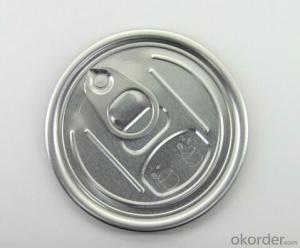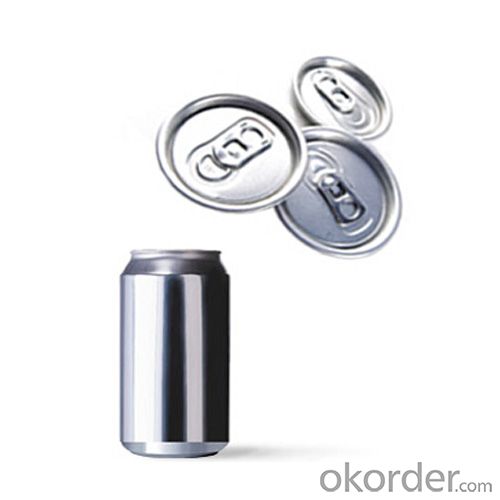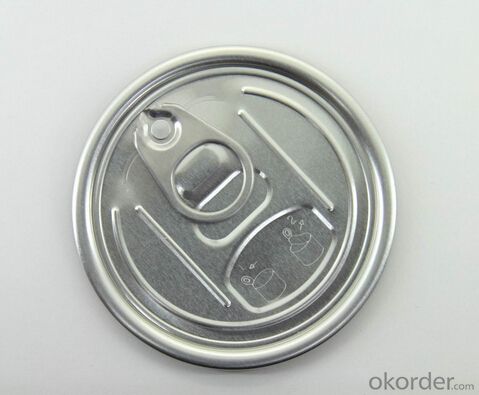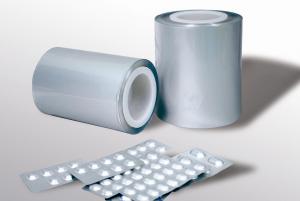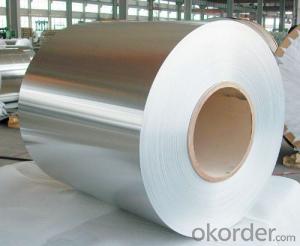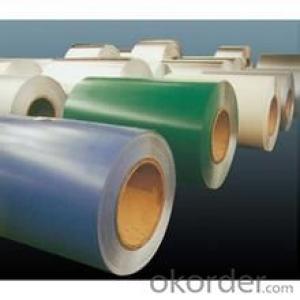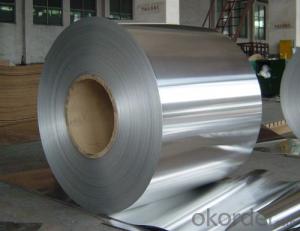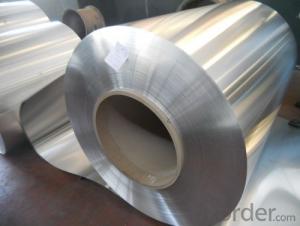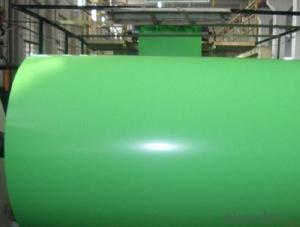Aluminum Cap Lid with Wholesale Price and High Quality
- Loading Port:
- Shanghai
- Payment Terms:
- TT OR LC
- Min Order Qty:
- 100000 m.t.
- Supply Capability:
- 10000000 m.t./month
OKorder Service Pledge
OKorder Financial Service
You Might Also Like
1.Structure of Aluminum Cap Lid Description:
5182 Aluminium coil can be used for aluminum can which is a container for packaging made primarily of aluminum (BrE aluminium).It is commonly used for foods and beverages but also for products such as oil, chemicals, and
other liquids.Most aluminum cans are made of two pieces. The bottom and body are "drawn" or "drawn and ironed" from a flat plate or shallow cup. After filling, the can "end" is sealed onto the top of the can. Aluminum cans are often made with recycled aluminum; approximately 68% of a standard North
American can is recycled aluminum.
2.Main Features of the Aluminum Cap Lid:
1)light weight
2)easily and economically recycled
3)superior barrier qualities
4)good formability
3.Aluminum Cap Lid Image:
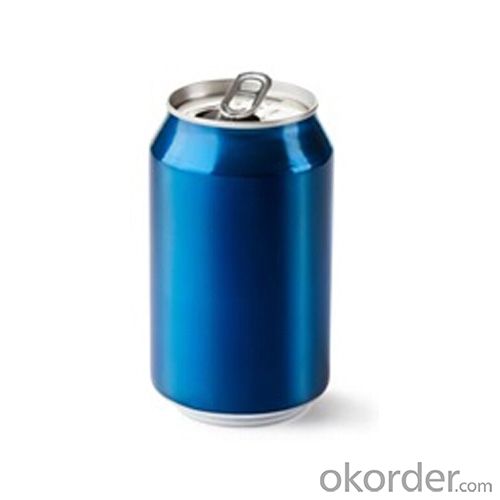
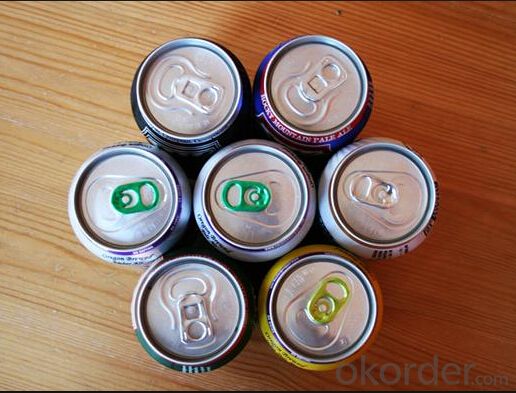
4. Aluminium Can Lid Specification:
Alloy | Temper | Thickness | Width | Prepainting |
A5052,A5182 | H19,H18,H16(H49,H48,H46) | 0.23~0.60mm | <1550mm< span=""> | EPOXY, PPG |
Inner Diameter | Outside Diameter | MOQ | Application | Coil Weight |
405,505,605mm | <1500mm< span=""> | 10 MT | Can Cover/Tab | <5 |
5.FAQ:
1) How about your quality?
Quality is priority! Every worker keeps the QC from the very beginning to the very end, Quality control department especially responsible for quality checking in each process.
2) How about the delievery time?
About 30-45 days
3) What is your payment terms?
TT or LC
- Q:Can aluminum coils be used for heat recovery systems?
- Yes, aluminum coils can be used for heat recovery systems. Aluminum is a highly conductive material that can effectively transfer heat, making it suitable for heat recovery applications. Its lightweight nature also allows for easy installation and maintenance of the system.
- Q:What are the insulation options available for aluminum coils?
- There are various insulation options available for aluminum coils, including fiberglass insulation, foam insulation, and elastomeric insulation. These insulation materials help to improve the energy efficiency of the coils and prevent condensation or heat loss.
- Q:Why there is always impression and indentation on the backup roller of aluminum coil rolling mill with 4 rollers.
- It is either the external or the bearing problem in designing and installing.
- Q:What is the maximum temperature that aluminum coils can withstand?
- The maximum temperature that aluminum coils can typically withstand is around 400-500 degrees Celsius (750-930 degrees Fahrenheit).
- Q:Can aluminum coils be used in the production of heat shields?
- Yes, aluminum coils can be used in the production of heat shields. Aluminum has excellent thermal conductivity, making it an effective material for transferring and dissipating heat. Additionally, it is lightweight and has good corrosion resistance, making it suitable for various applications where heat protection is required, such as in automotive or aerospace industries.
- Q:How do aluminum coils compare to other types of coils (e.g., copper)?
- The usage of aluminum coils and copper coils is prevalent in multiple industries. While each type has its own pros and cons, it is crucial to understand their relative comparisons. An important distinction between aluminum and copper coils is their conductivity. Copper is renowned for its exceptional electrical and thermal conductivity, making it the preferred choice for applications that necessitate efficient heat transfer. Conversely, aluminum possesses lower conductivity than copper, yet it still conducts electricity and heat effectively. Another factor to consider is cost. Copper is more expensive than aluminum due to its higher demand and limited availability. Consequently, aluminum coils are often chosen as a cost-effective alternative, particularly in applications where the high conductivity of copper is not necessary. In terms of weight, aluminum coils are significantly lighter than copper coils. This attribute facilitates easier handling and installation, leading to reduced transportation and labor costs. The lightweight nature of aluminum coils also renders them suitable for weight-sensitive applications, such as automotive and aerospace industries. In terms of corrosion resistance, copper coils outperform aluminum coils. Copper exhibits high resistance to corrosion, ensuring a longer lifespan and reduced maintenance requirements. Conversely, aluminum is more prone to corrosion, especially in environments with high humidity or exposure to specific chemicals. However, through proper coatings and treatments, aluminum coils can be effectively protected against corrosion. Durability is another crucial aspect to consider. Copper coils are known for their durability and ability to withstand extreme conditions, making them suitable for applications requiring longevity. While aluminum coils may not be as durable as copper, they can still offer satisfactory performance in many applications, particularly when designed and maintained appropriately. In conclusion, aluminum coils and copper coils possess distinct characteristics and advantages. Copper coils offer superior conductivity, corrosion resistance, and durability, albeit at a higher cost. On the other hand, aluminum coils are lighter, more cost-effective, and suitable for various applications. Ultimately, the choice between the two types of coils depends on specific requirements, budget constraints, and environmental factors of the given application.
- Q:What are the different types of protective coatings for aluminum coils?
- There are several types of protective coatings available for aluminum coils, including polyester, polyvinylidene fluoride (PVDF), acrylic, epoxy, and polyurethane. These coatings provide varying degrees of protection against corrosion, UV rays, and other environmental factors, ensuring the longevity and durability of the aluminum coils.
- Q:What is the weight of an aluminum coil?
- The weight of an aluminum coil is subject to variation based on its dimensions, gauge, and length. Generally, aluminum coils tend to range from 1,500 to 6,000 pounds in weight. Nevertheless, it is important to acknowledge that the weight of individual aluminum coils may differ, either exceeding or falling short of these figures, owing to the unique demands and specifications of the coil.
- Q:Are aluminum coils suitable for insulation jacketing?
- Indeed, insulation jacketing can be effectively achieved with aluminum coils. Renowned for their exceptional thermal properties, durability, and resistance to corrosion, aluminum coils are a highly favored choice for jacketing material. They find extensive application across diverse industries such as HVAC, oil and gas, and petrochemical, where they serve to insulate pipe systems and equipment. By enveloping insulation materials, aluminum coils play a crucial role in safeguarding against moisture infiltration and sustaining thermal efficiency. Moreover, their lightweight composition ensures effortless installation and transportation. Ultimately, aluminum coils emerge as a dependable and efficient solution for insulation jacketing endeavors.
- Q:need to know the procedure for removal of aluminum windows with brick trim
- We contemplated this issue ourselves... The best suggestion we got from a friend who was a window installer was to measure the existing window carefully and order a custom replacement Block frame window. To remove the existing window (once you have verified that the window you recieved is actually the size you ordered--don't skip this step!) Remove the vent and sash from the aluminum window -- this may mean some glass breakage so be careful and use gloves. Use a sawzall or reciprocating saw to cut along the outside edge of the window where the nailing fin should be attaching it to the framing beneath the block or brick. If you use the correct blade, you should have no trouble cutting through the aluminum. Make sure to wear saftey glasses as you DO NOT want aluminum shavings in your eyes! Once your opening is clear, level and plumb the new window using shims and screw directly through the inside of the window frame into the frame of the opening. You will need to get covers for the screw heads so that they don't show once your installation is complete. Good Luck!
1. Manufacturer Overview |
|
|---|---|
| Location | |
| Year Established | |
| Annual Output Value | |
| Main Markets | |
| Company Certifications | |
2. Manufacturer Certificates |
|
|---|---|
| a) Certification Name | |
| Range | |
| Reference | |
| Validity Period | |
3. Manufacturer Capability |
|
|---|---|
| a)Trade Capacity | |
| Nearest Port | |
| Export Percentage | |
| No.of Employees in Trade Department | |
| Language Spoken: | |
| b)Factory Information | |
| Factory Size: | |
| No. of Production Lines | |
| Contract Manufacturing | |
| Product Price Range | |
Send your message to us
Aluminum Cap Lid with Wholesale Price and High Quality
- Loading Port:
- Shanghai
- Payment Terms:
- TT OR LC
- Min Order Qty:
- 100000 m.t.
- Supply Capability:
- 10000000 m.t./month
OKorder Service Pledge
OKorder Financial Service
Similar products
New products
Hot products
Hot Searches
Related keywords

